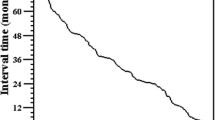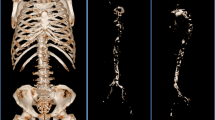Abstract
Background
Cardiovascular disease (CVD) is an important cause of morbidity and mortality in peritoneal dialysis (PD) patients. Cardiovascular calcification (CVC) is highly prevalent in PD patients and could predict their cardiovascular mortality. Soluble urokinase plasminogen activator receptor (suPAR) is closely associated with coronary artery calcification in hemodialysis patients and is an important predictor of CVD. However, the role of suPAR in PD patients is poorly understood. We investigated the relationship between serum suPAR and CVC in PD patients.
Methods
Abdominal aortic calcification (AAC) was assessed by lateral lumbar radiography, coronary artery calcification (CAC) by multi-slice computed tomography, and cardiac valvular calcification (ValvC) by echocardiography. CVC was defined as confirmed presence of calcification in one site (AAC, CAC, or ValvC). Patients were divided into CVC group and non-CVC group. Demographic characteristics, biochemical variables, comorbidities, PD regimen, serum suPAR, and medication were compared between the two groups. Logistic regression was conducted to determine association between serum suPAR and presence of CVC. The receiver–operator curve (ROC) was plotted to calculate the area under the curve (AUC) for suPAR to identify CVC and ValvC.
Results
Of 226 PD patients, 111 (49.1%) had AAC, 155 (68.6%) had CAC, and 26 (11.5%) had ValvC. There were significant differences in age, BMI, diabetes, white blood cell, phosphorus, hs-CRP, suPAR, time on dialysis, total volume of dialysate, ultrafiltration, volume of urine, and Kt/V between CVC and non-CVC group. Serum suPAR was associated with CVC by multivariate logistic regression analysis in PD patients, especially in elderly patients. The levels of serum suPAR were closely related to the degree of AAC, CAC, and ValvC in PD patients. The incidence of CVC was higher in patients with higher levels of suPAR. The ROC curve showed that serum suPAR had a predictive value for CVC (AUC = 0.651), especially for ValvC (AUC = 0.828).
Conclusion
Cardiovascular calcification is prevalent in PD patients. High levels of serum suPAR are associated with cardiovascular calcification in PD patients, especially in elderly patients.





Similar content being viewed by others
Data availability
The datasets generated and analyzed during the current study are available from the corresponding author on reasonable request.
References
Modi ZJ, Lu Y, Ji N et al (2019) Risk of cardiovascular disease and mortality in young adults with end-stage renal disease. Jama Cardiol 4:353
Li J, Li Y, Zou Y et al (2022) Use of the systemic inflammation response index (SIRI) as a novel prognostic marker for patients on peritoneal dialysis. Ren Fail 44:1227–1235
KDIGO (2017) Clinical practice guideline update for the diagnosis, evaluation, prevention, and treatment of chronic kidney disease-mineral and bone disorder (CKD-MBD). Kidney Int Suppl 2011(7):1–59
Liu ZH, Yu XQ, Yang JW et al (2018) Prevalence and risk factors for vascular calcification in Chinese patients receiving dialysis: baseline results from a prospective cohort study. Curr Med Res Opin 34:1491–1500
Seyahi N, Alagoz S, Atli Z et al (2022) Coronary artery calcification progression and long-term cardiovascular outcomes in renal transplant recipients: an analysis by the joint model. Clin Kidney J 15:101–108
Eapen DJ, Manocha P, Ghasemzadeh N et al (2014) Soluble urokinase plasminogen activator receptor level is an independent predictor of the presence and severity of coronary artery disease and of future adverse events. J Am Heart Assoc 3:e1118
Drechsler C, Hayek SS, Wei C et al (2017) Soluble urokinase plasminogen activator receptor and outcomes in patients with diabetes on hemodialysis. Clinical J Am Soc Nephrol 12:1265–1273
Wu W, Cui Y, Hu J et al (2018) Soluble urokinase plasminogen activator receptor is associated with coronary artery calcification and cardiovascular disease in patients undergoing hemodialysis. Kidney Blood Press Res 43:664–672
Levey AS, Stevens LA, Schmid CH et al (2009) A new equation to estimate glomerular filtration rate. Ann Intern Med 150:604–612
Kauppila LI, Polak JF, Cupples LA et al (1997) New indices to classify location, severity and progression of calcific lesions in the abdominal aorta: a 25-year follow-up study. Atherosclerosis 132:245–250
Agatston AS, Janowitz WR, Hildner FJ et al (1990) Quantification of coronary artery calcium using ultrafast computed tomography. J Am Coll Cardiol 15:827–832
Wlazel RN, Szwabe K, Guligowska A, et al (2020) Soluble urokinase plasminogen activator receptor level in individuals of advanced age. Sci Rep 10
Guan J, Xie H, Wang H et al (2023) Cardiac valve calcification as a predictor of cardiovascular outcomes in peritoneal dialysis patients: an inverse probability of treatment weighting analysis. Int Urol Nephrol 55:1271–1278
Hindy G, Tyrrell DJ, Vasbinder A, et al (2022) Increased soluble urokinase plasminogen activator levels modulate monocyte function to promote atherosclerosis. J Clin Invest 132
Nikorowitsch J, Borchardt T, Appelbaum S et al (2020) Cardio-renal biomarker soluble urokinase-type plasminogen activator receptor is associated with cardiovascular death and myocardial infarction in patients with coronary artery disease independent of troponin, C-reactive protein, and renal function. J Am Heart Assoc 9:e15452
Jhee JH, Nam BY, Lee CJ et al (2021) Soluble urokinase-type plasminogen activator receptor, changes of 24-hour blood pressure, and progression of chronic kidney disease. J Am Heart Assoc 10:e17225
Shuai T, Yan P, Xiong H et al (2019) Association between soluble urokinase-type plasminogen activator receptor levels and chronic kidney disease: a systematic review and meta-analysis. Biomed Res Int 2019:6927456
Pawlak K, Pawlak D, Mysliwiec M (2007) Excess soluble urokinase-type plasminogen activator receptor in the plasma of dialysis patients correlates with increased fibrinolytic activity. Thromb Res 119:475–480
Wlazeł RN, Szadkowska I, Bartnicki P et al (2018) Clinical and prognostic usefulness of soluble urokinase plasminogen activator receptor in hemodialysis patients. Int Urol Nephrol 50:339–345
Torino C, Pizzini P, Cutrupi S et al (2018) Soluble urokinase plasminogen activator receptor (suPAR) and all-cause and cardiovascular mortality in diverse hemodialysis patients. Kidney Int Rep 3:1100–1109
Pawlak K, Mysliwiec M, Pawlak D (2010) Haemostatic system, biochemical profiles, kynurenines and the prevalence of cardiovascular disease in peritoneally dialyzed patients. Thromb Res 125:e40–e45
Sun M, Chang Q, Xin M et al (2017) Endogenous bone morphogenetic protein 2 plays a role in vascular smooth muscle cell calcification induced by interleukin 6 in vitro. Int J Immunopathol Pharmacol 30:227–237
Benz K, Varga I, Neureiter D et al (2017) Vascular inflammation and media calcification are already present in early stages of chronic kidney disease. Cardiovasc Pathol 27:57–67
Lyngbaek S, Sehestedt T, Marott JL et al (2013) CRP and suPAR are differently related to anthropometry and subclinical organ damage. Int J Cardiol 167:781–785
Sorensen MH, Gerke O, Eugen-Olsen J et al (2014) Soluble urokinase plasminogen activator receptor is in contrast to high-sensitive C-reactive-protein associated with coronary artery calcifications in healthy middle-aged subjects. Atherosclerosis 237:60–66
Pawlak K, Mysliwiec M, Pawlak D (2008) The urokinase-type plasminogen activator/its soluble receptor system is independently related to carotid atherosclerosis and associated with CC-chemokines in uraemic patients. Thromb Res 122:328–335
Sánchez Duffhues G, García De Vinuesa A, van de Pol V et al (2019) Inflammation induces endothelial-to-mesenchymal transition and promotes vascular calcification through downregulation of BMPR2. J Pathol 247:333–346
Funding
This study was supported by Health Science and Technology Program of Zhejiang Province of China (Grant No. 2022KY396; Grant No. 2022KY1300).
Author information
Authors and Affiliations
Corresponding author
Ethics declarations
Conflict of interest
The authors report no conflict of interest.
Additional information
Publisher's Note
Springer Nature remains neutral with regard to jurisdictional claims in published maps and institutional affiliations.
Rights and permissions
Springer Nature or its licensor (e.g. a society or other partner) holds exclusive rights to this article under a publishing agreement with the author(s) or other rightsholder(s); author self-archiving of the accepted manuscript version of this article is solely governed by the terms of such publishing agreement and applicable law.
About this article
Cite this article
Guan, J., Gong, S., He, Q. et al. Soluble urokinase plasminogen activator receptor is associated with cardiovascular calcification in peritoneal dialysis patients. Int Urol Nephrol 56, 191–198 (2024). https://doi.org/10.1007/s11255-023-03623-z
Received:
Accepted:
Published:
Issue Date:
DOI: https://doi.org/10.1007/s11255-023-03623-z




